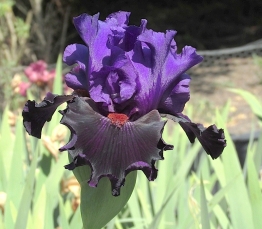The ‘Wild Kingdom’ Comes to Your Garden!
The ‘Wild Kingdom’ Comes to Your Garden!
(Bob Sussman 5/3/15 – With sections take from unpublished e-book from David
Sussman.
“Where have all the wild things gone – the bees, butterflies and hummingbirds?
They’re all right here in our garden.”
I got a phone call today from a man who asked me if I knew a contractor that could take out his lawn? Sure, I can recommend someone to do that. Is there anything else? Well, he said that he has a small butterfly garden in his backyard and that his kids love watching all the butterflies and caterpillars, but the front lawn is just a “waste of space. “
With higher and higher water rates and subsidies for low water-using landscapes, the economics for transforming your traditional garden pay. So a lawn is a waste of space!
Enter the ‘Wild Kingdom’! The ‘Wild Kingdom’ is where the cool butterflies, caterpillars, birds, and bees live. Your garden can be a ‘Wild Kingdom’ too! Having all these living creatures adds another dimension to your garden that conventional gardens don’t have. When your garden becomes a ‘Wild Kingdom’, you’ll have an endless variety of creatures whose performances you’ll be able to watch with a front row seat.
So how is all this done? These creatures all operate on the same principles as teenagers – they need to eat! They need to eat constantly during the day. What do they eat?
Attracting birds and butterflies requires all kinds of flowering plants, and if you want to have 12 months of the ‘Wild Kingdom’, you have to have flowers all year. The more flowers, the more “bug” drama.
So much selection, so much to know, what to do?
Well there is a lot of selection and there is a lot to know, but we’re going to narrow this down to some basic choices that will give you a good result without becoming an expert. Yes you, that’s you, can probably do all or most of this yourself. If you should need some help, or want to get fancy, there are plenty of places to go and people to call for help.
Over the years, we’ve grown a variety of different plants at the nursery and designed more than a few gardens too; although we’re the nursery guys, not the design guys. Some plants just attract more cool stuff, are easier to grow, and flower for a large part of the year. The following are my Top 10!
Matilija Bob’s Top 10
- Milkweed- Asclepias fascicuaris or narrow leaf milkweed.
Take a look!!!
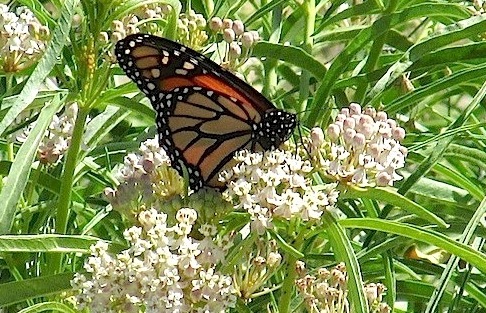
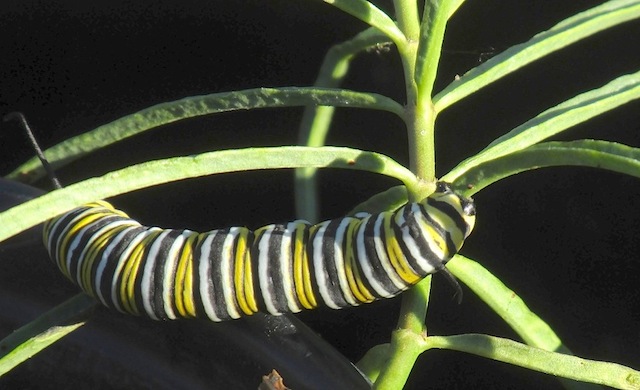
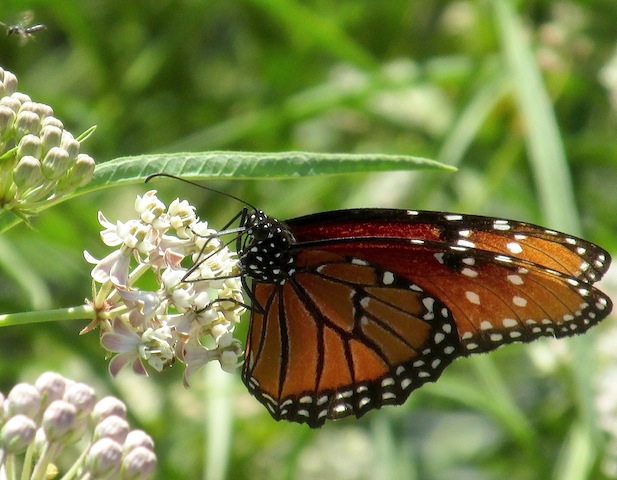
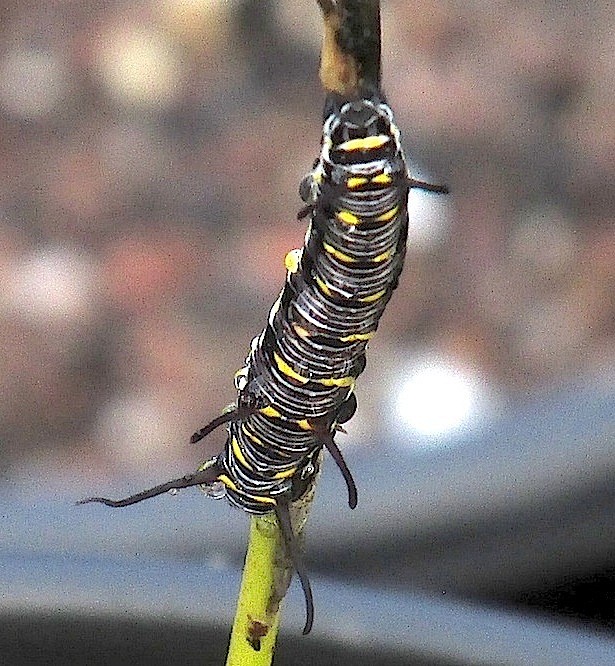
This milkweed is native throughout California, Oregon, and the Southwest. It is the larva plant for both monarch caterpillars and queen butterfly caterpillars too. This is a tremendous nectar plant that feeds all kinds of butterflies and other flying creatures. If you want the ‘Wild Kingdom’ in your garden, this is a good place to start. These do die back to the ground each winter, so plant them in the back of the garden and/or with other somewhat shorter flowering evergreen plants around it (try the Verbena lilacina).
2. Verbena lilacina ‘De la mina’
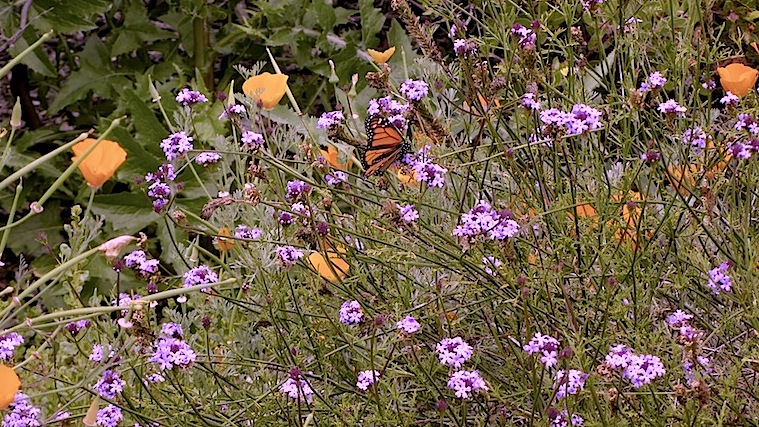
Some of my native plant friends refer to this as a California native, but it’s actually from Cedros Island off the coast of Mexico. Few perennials flower all year as these do. Few flowering plants will flower in full sun and partial shade, but these do. Few plants constantly provide nectar to butterflies and bees, but yes, these do. This is something you’d plant in front of your narrow leaf milkweed because when your narrow leaf milkweed goes dormant and dies back to the ground, these will be in flower.
3. Desert hybrids- Sphaeralcea Hybrids.
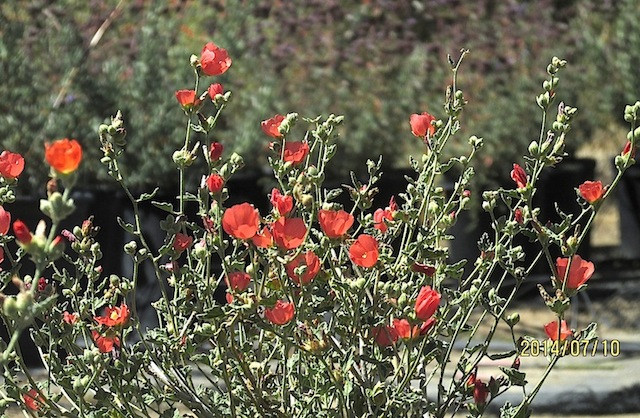
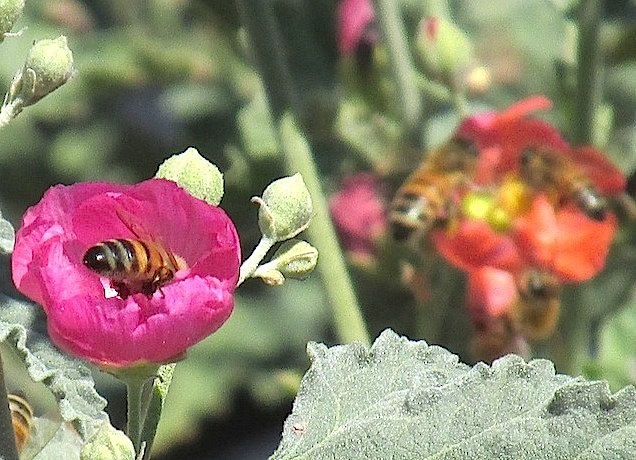
In California, these are mostly orange flowering perennials that will flower all year. When you get into other parts of the Southwest where they grow, you find other colors like pinks and reds. These are excellent bee plants, providing a continuous fresh supply of pollen.
4. Salvia lemmonii- Lemmon’s Sage.
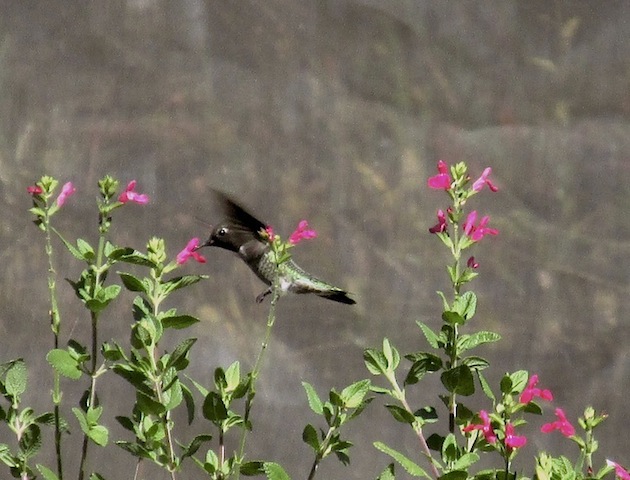
A native of New Mexico, this sage will flower all year in a sunny spot. In a shady spot, they’ll still flower but in spring and fall only. Bright red flowers will bring on the hummingbirds. Since these can get to be a good size – H 4’+ x W 4’+, plant against a wall, fence, or even better – against a window, and you can see the hummingbirds from inside your house.
5. Galvezia – Island Snapdragon.
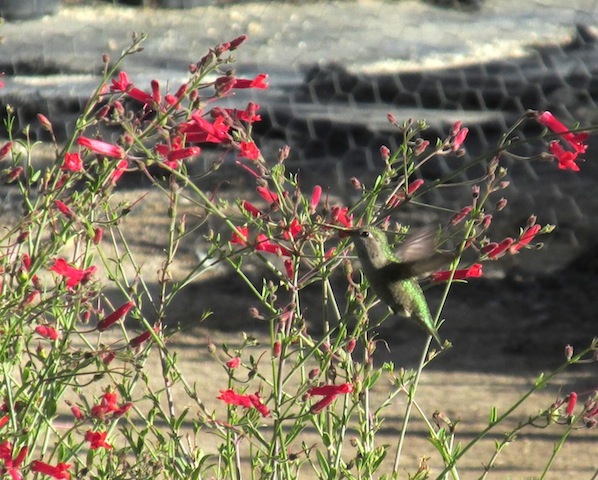
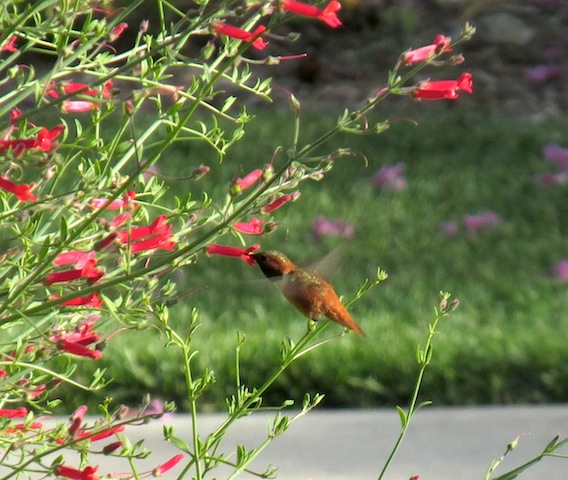
There are a few species of Galvezia that are native to both Channel Islands and Cedros Island off the coast of Baja. The main feature of these is that they are excellent hummingbird plants. Since they can flower all year (unless you get a hard frost) their red flowers will bring feeding hummingbirds buzzing all year. Easy to grow, cut dead flowers back and they’ll flower again. Grow these in partial shade or full sun. Size is between 3’ x 3’ to 4’ x 4’. These are good container plants for a patio, too.
6. Monardella odoratissima–Mountain Mint.
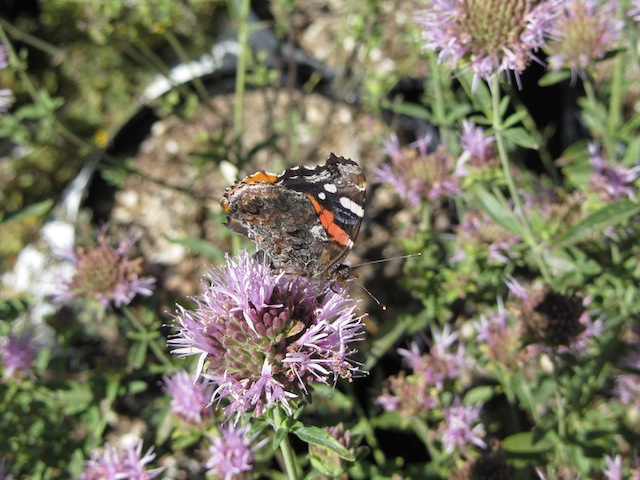
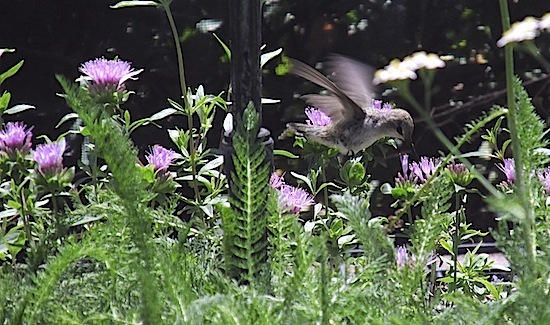
Mountain mint. These are small, long, flowering perennials that have a fabulous minty fragrance, and you can’t beat them as a nectar producer attracting and feeding all kinds off cool creatures. They are excellent for meadow gardens or perennial borders. You’ll be able to watch an array of wild things flying around. H – 1’ x W -1-1/2’. They will flower from spring through fall – sun to part shade.
7. Romneya coulteri- Matilija Poppy.
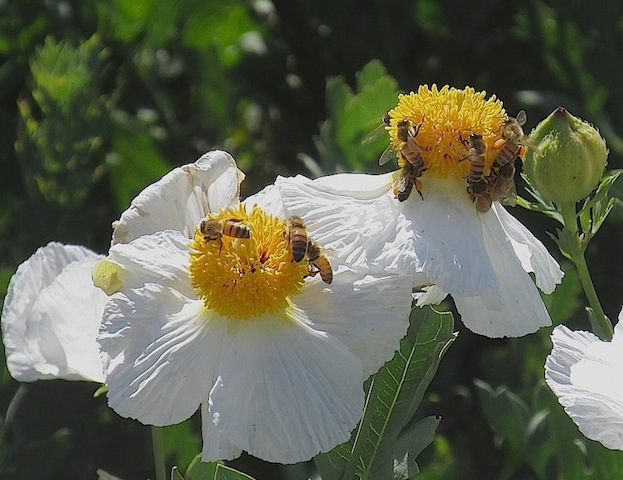
These are the largest flowering California natives and the flowers can reach 6” across. They flower from mid-March through mid-summer and with a little water, can flower through August. As you can see, these are tremendous “bee” flowers that produce lots of pollen. Plant in a large area, but watch out, as these can get tall (7’) and spread by underground runners!
8. Salvia chamaerdryoides- Mexican Blue Sage.
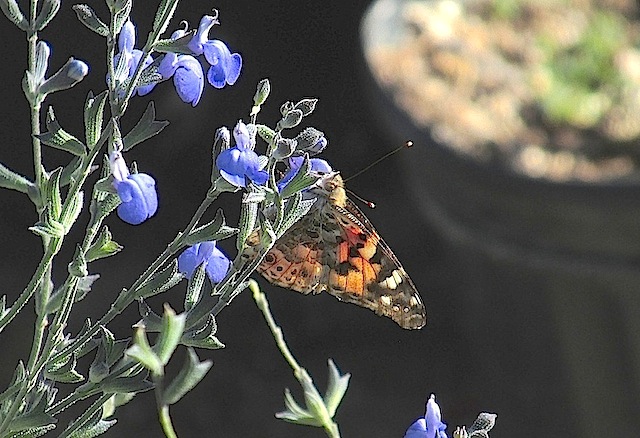
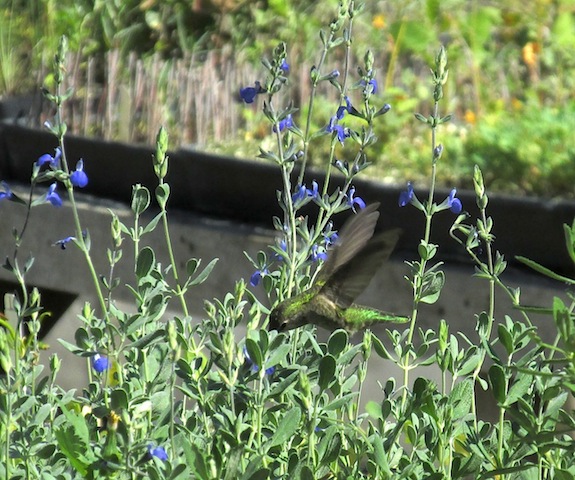
These are natives to Mexico with blue flowers that bloom all year in southern California. Their size of 2’ x 2’ makes them a perfect fit for many spaces. Plant these in full sun to part shade. They are great nectar producers making them favorites for both butterflies and hummingbirds.
9. Zauschneria species-California fuchsia
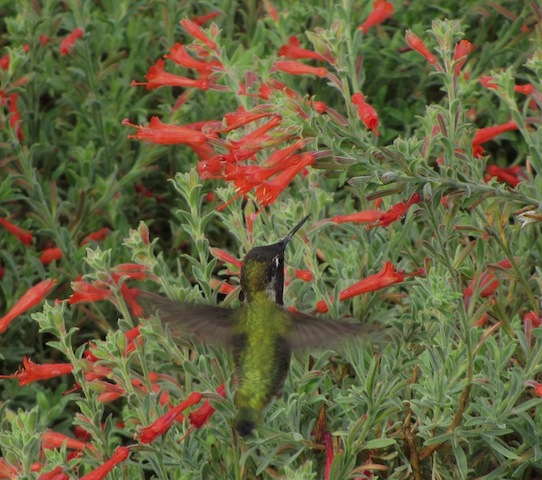
California fuchsia is an important class of native plants that flower mid-summer through fall. Typically, they are small (H 1-1/2’ x W 2’) with red nectar producing flowers that feed the hummingbirds. Once established, they are very drought tolerant. Plant in full sun.
10. Salvia spathacea – hummingbird sage
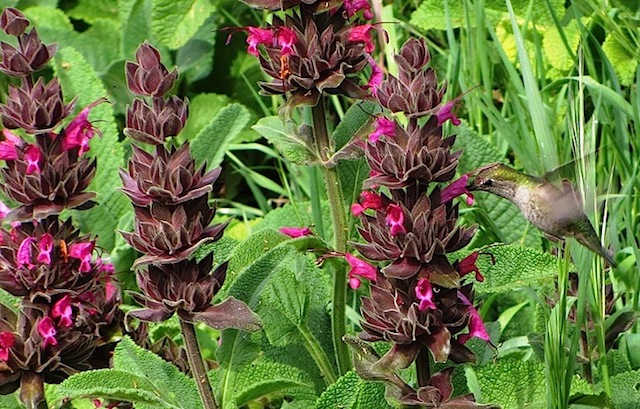
In nature, you would find hummingbird sage in shaded areas, often growing under oak trees in large groves with their magenta flowers. They are a spreading ground cover with flower spikes that are 2’ tall (some can be taller) that act as natural hummingbird feeders. While blooming in spring, with a little water in late summer, they can flower from fall into winter.
Our TOP 10?
Yes, these are our top 10 very drought tolerant favorites for bringing cool wildlife into your garden. They were picked because they either flower all year, have extended bloom times, or flower in the offseason when other things don’t. This doesn’t mean you can’t add all kinds of other plants like California lilacs (Ceanothus), other sages, manzanitas, chocolate dasies, blue mistflowers, or columbines, etc…. I’ve got lots of other California natives in my garden too. As long as you have some of these, your garden will be buzzing, fluttering, and singing!

